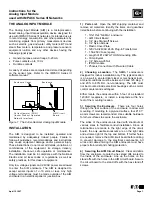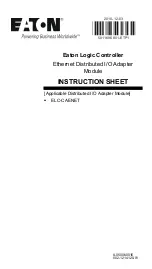
Sometimes, you may need to adjust the various configuration jumpers in order to wholly exploit all the features of the monitor.
Fig. 5
shows the different programming devices described here below:
A.
Selection of video signal input impedance.
The slider switch “
A
” of
fig. 5
allows to select the impedance value for the video signal input. By setting such switch on “
L
”
the selected impedance will be low (typically, 75 Ohm), while by setting it on “
H
” the resulting value will be (
47,000 Ohm)
.
By default, all monitors are supplied with such a switch in position “
L
”.
To set this switch correctly, remember it must be placed:
•
On “
L
” position for systems with SD55 video splitters at each floor (e.g. apartment buildings….) .
•
On “
L
” position for one-family systems (one-to-one installations)
•
On “
H
” position for systems with several looping monitors, without video splitter box. They are defined as “entry/exit” systems
where the video signal connecting wires arrive directly on A and B terminals of one monitor and leave from the same
terminals toward the next monitor. Pay attention in this configuration to closing resistors.
B.
Jumpers selection
The programming jumpers differ according to monitor type and are shown in
fig 5a/5b
. They are used to:
•
Select the flor call type accepted by the monitor
NOT AVAILABLE ON MV-MVC1000
•
Activate €BUS call repetition on P terminal or not
NOT AVAILABLE ON MV-MVC1000
•
To activate and exclude conversation privacy
•
To choose between traditional system and €-BUS system operation.
NOT AVAILABLE ON MV-MVC1000
Jumper J1 -
System type selection.
NOT AVAILABLE ON MV-MVC1000
Jumper J1 is used to select the system type.
•
With “
J1
” jumper between “
1
” and “
2
” (default setting) the monitor works (similarly to MV100 models) in 5-wire video
sistem (without coaxial cable).
•
With “
J1
” jumper between “
2
” and “
3
” the monitor is set for €-BUS operation. In this condition, a properly connected
monitor (equipped with TDE3000-AV 0086/02E, TDE82 AN 9847 or MTE82 AN 6314) will ring only when receiving a
call code that matches the ID number set on its onboard DIP-SWITCH (
fig.5
–
D
). For programming instructions,
please refer to the chapter relevant to call codes set up in €BUS systems.
Jumper J2
-
Activation / exclusion of conversation privacy.
J2
jumper controls the conversation privacy feature as follows:
•
With “
J2
” positioned between “
1
” and “
2
” (default setting) the conversation privacy is excluded. Thus, voice
communication with the visitor panel is possible any time the handset of the monitor is picked up.
•
With “
J2
” between “
2
” and “
3
” the conversation privacy feature is active. An external call must be received to establish
communication with the visitor panel and to open the door.
NOTE:
When installing a system with conversation privacy activated, ALL the monitors must have the “
J2
” jumper set
in the same (
2-3
) position.
Jumper J3
-
Є
BUS successful call confirmation tone
NOT AVAILABLE ON MV-MVC1000
Jumper
J3
sends a special confirmation tone to the
P
terminal upon verifying the successful delivery of the
Є
BUS call. By
default, this function is not enabled. The monitor WILL NOT repeat the signal on the
P
terminal following a call.
•
With jumper
J3
positioned between
1
and
2
(default setting), the system WILL NOT be enabled to repeat successful
Є
BUS calls.
•
With jumper
J3
positioned between
2
and
3
the system will be enabled to repeat on terminal
P
the
negative
call from
the TDE digitiser. This function may be used to activate a supplementary ringer in €BUS systems.
Jumper J4
-
Auxiliary call type selection
NOT AVAILABLE ON MV-MVC1000
Jumper
J4
is used to determine the auxiliary call type that the monitor can reproduce. The ringer volume CANNOT be
adjusted in the described configuration. This function is NOT ENABLED as a standard feature because the monitor is
equipped with an internal three-tone DIN DON DAN electronic ringer.
WARNING:
In the following configurations, the monitors may also provide the DIN DON DAN function.
•
With jumper
J4
positioned between
1
and
2
, the system will be enabled to reproduce the two-tone call from external
loud speaker to the terminal C in the monitor..
•
With jumper
J4
positioned between
2
and
3
, the system will be enabled to reproduce the call from the monitor from
terminal
P
. This call must be
negative
with respect to terminal 1, for example, calls from A70/IRC or A3000 power unit.
The default position is with jumper inserted on the
J4 central
contact only.
C.
Video signal amplification setting
The trimmer “
C
” in
fig.
5
is used to increase the video amplifier gain to compensate for possible signal attenuations along the
transmission line.
Such trimmer is factory-set for optimal performance; it should not be further adjusted other than in situations of extremely
long lines (over 200 m), or where considerable picture deterioration occurs. Sometimes, with MVC3000 monitors such
trimmer can be very useful in colour systems where only monochrome pictures are received due long distances involved.
D.
Programming of call codes in €BUS systems
NOT AVAILABLE ON MV-MVC1000
The dip-switch indicated “
D
” in fig.
5
is used to assign a unique call code to every user.
The operation is quite simple, and it can be done by a single person setting the mentioned DIP SWITCH, directly in the
various apartments as follows:
•
List down the location numbers of call buttons corresponding to each user (you may use the form provided in the
digitiser instruction booklet).
•
Program every monitor by assigning it the value of the corresponding push button. A small screwdriver could be used
to expedite the dip-switch programming operation .
To determine how to set dip-switches correctly, remember that each switch takes up a different value according to its
relevant position, as specified in the following table.
Position Decimal
value
1 1
2 2
3 4
4 8
5 16
6 32
7 64
8 128
To program a given code, it is necessary to move to the
OFF
position only those switches whose values add up to the
required code; leave all other switches in
ON
position.
NOTE: The digits marked on the Dip-Switches refer to their relevant positions and NOT to
their decimal value.
Code programming example
For instance, suppose we want to programme a user with code “13”:
As 13 is obtained by adding 1, 4, and 8, it will be necessary to move the
first
, the
third
and the
fourth
switch to the
OFF
position
, as indicated by the chart above. All other switches shall remain in
ON position
..
Dip-switch
VALUES
Esempio di codifica del codice 13 pari a 1 + 4 + 8 = 13
6
2
3
4
5
6
7
8
1
2
4
8
16
32
64
128
ON
OFF
11
12


























